|
As a proper Russian immigrant in America I must bake Irish Soda Bread every year for Saint Patrick’s Day. Just kidding! I LOVE baking, my husband is Irish and even more than baking, I love making him happy. This year we are expecting some of the best people in Tampa to join us in celebrating Saint Pat’s, so I decided to try a few authentic recipes from the “Irish Heritage Cookbook”. Here are my favorites:  Irish Soda Bread This recipe is very close to the one entered into the 1997 cooking contest sponsored by Fitzpatrick Manhattan Hotel (687 Lexington Avenue). I soaked golden raisins in whiskey for about 30 minutes and used what was left of liquid to make whiskey butter. Trust me, it’s totally worth it! I also substituted corn oil with vegetable oil because I could not find a small bottle of corn oil in the store (this is the only time I would ever use corn oil). 1 cup of golden raisins soaked in 1/2 cup of whiskey for 30 minutes 4 cups all-purpose flour (I use King Arthur) ¼ cup sugar 1 tsp baking soda 2 tsp baking powder 1 tsp salt 2 large eggs 1 ¼ cups buttermilk ¼ cup corn oil 2 teaspoons caraway seeds 1 tbsp milk Preheat the oven to 350F. Lightly grease baking sheet or line it with parchment paper. In a large bowl, stir the flour, sugar, baking soda, baking powder, and salt together. In a separate bowl, beat the eggs, buttermilk, and oil together. Make a well in a center of the dry ingredients and pour in a buttermilk mixture. Add the caraway seeds and drained raisins. Stir until soft dough has formed. Shape the dough into a large ball on a lightly floured board (flour your hands if necessary for easier handling). With a sharp knife, make a cross on the center of the top. Place on the prepared pan. Brush the top with milk. Sometime I like to sprinkle some festive sugar on the top (green for this occasion). Bake in the center of the oven until golden brown, 30-40 minutes. 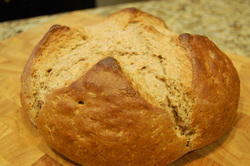 Mills Inn Brown Soda Bread Traditionally, Irish Soda Bread is made with a combination of white and whole-wheat (or any kind of brown) flours. This recipe is from Donal Scannel’s Mills Inn in Ballyvourney, County Cork. 2 cups coarse whole-wheat flour (because I lived 10 years in Vermont, I am biased towards King Arthur flour). You can also use 1 cup each wheat bran and old-fashioned oatmeal 2 cups all-purpose flour ½ tsp salt 1 tsp baking soda ½ tsp cream of tartar ¼ cup sugar 4 tbsp cold butter 2 cups buttermilk Preheat the oven to 400F. Lightly grease a 9-inch round cake pan (you can also shape the dough into a ball by hand and use baking sheet covered with parchment paper). In a large bowl, stir the flours, salt, baking soda, cream of tartar, and sugar together. With a pastry cutter, or your fingers, cut the butter into the dry ingredients to the texture of coarse crumbs. Make a well in the center and add the buttermilk. With a wooden spoon or your hands, mix until a soft dough is formed. Turn the dough out onto a floured board and knead lightly, just enough to form a large ball. Flour your hands if necessary for easier handling. Flatten slightly. With a sharp knife, make a cross on the top. Brush the top with milk; this will make a glossy crust. Place the dough in the prepared pan and bake until the bread is lightly browned and sounds hollow when tapped, 35-40 minutes. 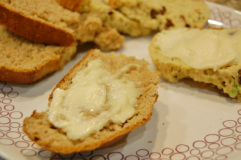 Whiskey Butter Use the whiskey leftover from soaking raisins and mix it with 9 tablespoons of soft (not melted) butter. Because we don’t use any emulsifiers, mixing alcohol with butter may take some time (it’s like trying to mix oil and vinegar). I found it easier to use an old fashioned mixer with beaters for this purpose. Enjoy!
0 Comments
 There will be no ‘before’ and ‘after’ pictures in this blog, mostly because I am not the type to flash my belly in a swim suit (regardless of how flat it may be). This blog is all about science of nutrition. Step 1: Food Diary There are a lot of different ways to keep a food log. In the old days I would simply record everything I consumed in a day and used a nutrition reference guide to break things down by carbohydrates, fat and protein. That was a lot of work! Now we can use all sorts of web and mobile apps. One of my favorites is MyFitnessPal – it is free, available online and on your phone and even has a barcode scanner. This app is similar to Weight Watchers, but you can actually see calories. (And did I mention free? As in not paying a corporation?) Do not forget to write down all the food you eat including condiments, sugar, and beverages for three non-consecutive days in a week – two week days and one weekend, then average the number of calories. Step 2: Body Mass Index Clinicians use the Body Mass Index (BMI) to assess a patient’s risk for developing obesity associated diseases. A normal weight BMI is 18.5 – 24.9; overweight is 25 – 29.9 and obese is 30 and greater. If my current weight is 150 lbs and my height is 5’2” (at least I like it to be that) my BMI can be calculated as: BMI = = x 703 = x 703 = 27.4 This puts me in the overweight category – I am not happy. Step 3: Resting Metabolic Rate Resting Metabolic Rate is the amount of energy (in calories) a person burns daily. We need this energy for keeping our vital organs alive and digesting the food we eat. In other words, if you lay in bed all day and do absolutely nothing RMR is how many calories you will burn. Here is an example of how RMR can be calculated: Weight – 150 lbs; Height – 5’2” or 62”; Age – 45; Gender - female Men: (9.99 x Weight (kg)) + (6.25 x Height (cm)) – (4.92 x Age (years)) +5 Women: (9.99 x Weight (kg)) + (6.25 x Height (cm)) – (4.92 x Age (years)) -161 = (9.99 x 68.2) + (6.25 x 157.5) – (4.92 x 45) – 161 = 681.3 + 984.4 – 221.4 – 161 = 1283.3 Kcal Step 4: Activity Level There are many different ways to determine daily activity level. This table is one of them; it helps you to find your activity factor to calculate the actual calories you burn every day, just be honest! I like to think I walk at least 7 miles every day which includes my morning routine of either walking or slow jogging for 45 minutes (approximately 3 miles), walking 30 minutes at lunch time (1.2 miles) and all other walking throughout the day: that can include office, grocery store, et cetera. The best way to confirm this is by purchasing a small pedometer and wearing it for a day. This will help estimate daily activity level with more precision.
My daily energy requirement can be calculated as follows: RMR x 1.6 = 1283.3 x 1.6 = 2053.28 Kcal Of course, when I average my food intake from my own food logs I notice that I consume at least 500 Kcal more than I should. No wonder I’m gaining weight! My smart book suggests subtracting 500 to 1000 Kcal from my energy requirement which will assure weight loss of 1 to 2 pounds per week. Well, let’s not go crazy, let’s be realistic. Losing one pound a week is great and brings me to get to my goal of 125 lbs in a little over half a year (4 lbs per month). Wow! But is it realistic? Not in my situation. What if I don’t have time to walk during the day? What if I drink an extra glass of wine? I don’t want to be disappointed. More to the point, I don’t want to be too restrictive in my diet and enjoy food. Losing a pound every two weeks is what I will be able to accomplish. This means subtracting 250 kcal from my daily energy requirements leaving me with approximately 1800 kcal per day. This is doable! Let’s begin.  No one likes to make New Year resolutions – not because the promise you give to yourself isn’t serious, but mostly because you can’t keep it: two weeks tops! It would be much safer not to make any resolutions at all; at least this is how I feel. Well, on this note I decided to make another New Year resolution. My logic includes the following: I am quite an accomplished individual, I finish what I start and with the best results possible. There are only two things in my life that I am always failing at – quitting smoking and losing weight. I lost weight once, in year 2000, dropped approximately 25 pounds, but over the past 13 years I got it all back and more. Quitting smoking was never successful. I tried every year, a few times a year over the last 17 years and failed every time. Year 2012 was the worst – I lost a job that I really liked followed by a serious back injury leaving me immobile for a few months. I could not run, could not walk, I could not even sit; lying down on the floor was my only option. Unfortunately, my appetite was not affected by the injury, so I gained a few more pounds. This year was good to me and I feel accomplished and successful, after all 13 is my lucky number! I graduated with my second Master’s degree, got an amazing job offer, fully recovered from the back injury and guess what? I QUIT SMOKING FOR GOOD! Yes, it’s been 6 months and I have not had a single cigarette! Now it’s time for the second task – lose weight. Generally speaking, I try to stay active and healthy as much as possible. I walk, ride my bike sometimes, and even started jogging again. I don’t eat junk food (chips, soda, etc.), and try to have a nutritionally balanced diet. But something is still missing. Slowly but surely my sizes go up and I start avoiding scales in the bathroom. One day I was reading the Health Magazine (not the best publication, but it happened to be in my hands at the time), and suddenly experienced a ‘light bulb’ effect. Eureka! I realized what was missing in my life – structure! So, as a nutritionist with training in counseling and dietetics I decided I should start with an assessment which includes a diet log (three non-consecutive days per week), calculations of BMI (Body Mass Index), and BMR (Basic Metabolic Rate). For nutrition nerds and just curious folks I’ll be posting formulas, calculations and examples of a diet log in my next post. Stay tuned!  By Anton Power What is an allergy in the first place? Allergies are hypersensitivity to the environment. When a foreign body enters our system, the normal immunological response produces a familiar inflammation that is felt when we, for example, catch a cold. However, many foreign chemicals are not harmful to our body. This obviously includes pollen, food and latex, among others. In regards to biological allergens; what makes them prone to cause an immune response is their chemical makeup. I’ve never heard of anyone becoming allergic to a steak dinner. However, most people are allergic to tree pollen to varying degrees, and some are allergic to peanuts. Note that hypersensitivity to food is not the same thing as intolerance. Allergic reactions are only immunologically related. However, food intolerance is the inability to digest certain chemicals and presents with symptoms akin to poisoning because the body simply doesn’t know what to do with it. Root Cause of Allergies Antigens are signaling proteins used for a variety of purposes. Our immune system has adapted to detect antigens of pathogens in order to protect us from infection. However, there are many reasons why antibodies that our body produces may recognize harmless chemicals from food and pollen as harmful. Furthermore, many other factors can contribute to exacerbating this error in recognition and thus make allergy sufferers feel sick. Over the past several decades, it has been shown that one antibody in particular, IgE, is directly related to allergic reactions in food. IgE is found in the gastrointestinal tract of people with food allergies in higher numbers than those without [1]. The mucosal layer of the intestines, of which the epithelium is the first row of cells, is the primary barrier by which potential pathogens are kept at bay. In order to transport antibodies beyond the mucosa from the lumen (outside) of the intestines, a transport protein (CD23) is found on both sides of the epithelium. Polymorphisms (common genetic variation) in the structure of the CD23 protein play an important part in how easily IgE proteins bound to allergens enter through the mucosal layer. Once below the mucosal layer, the allergen bound IgE protein induces an immune response. Thus, some people will inherently be more prone to allergic reactions in food [1]. If a person is more prone to food allergies, then low-level exposure to the allergen can damage the epithelium over time because the immune response inherently does damage to the surrounding cells. If the mucosa is not given enough time to heal, damage will go unrepaired. This is why physicians caution people with known allergies to avoid contact with the allergen. If the epithelium is damaged, then allergen bound IgE will be free to enter the mucosa and produce a chronic inflammatory response. This can be dangerous and taxes the body’s ability to protect itself. Risk Factors As discussed above, allergic response to food has been shown to sometimes be genetic. However, other risk factors do apply. For example, alcoholism; alcohol dehydrates the mucosal layer of the intestinal wall [2]. This does direct damage to the epithelium and increases permeability, allowing for foreign substances such as allergen bound IgE to enter the body unrestricted. Although only 3.2% of the adult population across the world develops food allergies, and only 1% of this population experiences fatal anaphylactic reactions, some of the risk can be mitigated [3]. As stated above, any substance (alcohol, aspirin) that can increase permeability of the mucosa in the intestines should be avoided, or used in moderation. It has also been shown that pollen allergy sufferers are at a higher risk of developing food allergies [3]. This may be related to the fact that allergy sufferers are already immune-compromised to some degree, or may have disproportionate amounts of IgE in certain anatomical regions where allergic response occurs [1]. In fact, adults with pollinosis (pollen allergies) are more likely to test positive or have a history of apple, peach, and celery allergies [4]. However, non-biological allergies, specifically latex, has also been found to be a risk factor for avocado and banana allergies [4]. Thus, knowing what we are allergic to now can help us determine what we may be allergic to in the future. However, it is entirely possible to know with certainty if you are willing to be tested. Companies now provide this service, but for a price. References [1] Hannah, J. G., & Sutton, B. J. (2008). Ige in allergy and asthma today. Nature Reviews Immunology, 8, 205-217. doi: doi:10.1038/nri2273. http://www.alergomed.org/uploads/1/0/0/2/10021998/lectura_prctica_-_ige_2.pdf [2] Bode, C., Bode, J.C. (2003) Effect of alcohol consumption on the gut. Best Pract Res Clin Gastroenterol, 17 (4), 575-592. Retrieved from http://www.ncbi.nlm.nih.gov/pubmed/12828956. [3] Moneret-Vautrin, D.A., Morisset, M. (2005). Adult food allergy. Current Allergy and Asthma Reports, 8 (1), 80-85. doi: 10.1007/s11882-005-0060-6. http://www.springerlink.com/content/9wu382n012h6nq61/ [4] Levy, M., Noirot, L. (2000). Allergic sensitization and clinical reactions to latex, food and pollen in adult patients. Clinical & Experimental Allergy, 30 (2), 270-275. doi: 10.1046/j.1365-2222.2000.00751.x http://onlinelibrary.wiley.com/doi/10.1046/j.1365-2222.2000.00751.x/abstract?deniedAccessCustomisedMessage=&userIsAuthenticated=false  At the end of my yoga teacher training course I was required to do a presentation on any topic that I consider myself to be an expert. That’s an easy task! I would like to share with you a Frequently Asked Questions (FAQ) session at the Vermont Yoga studio where I presented ‘Nutrition 101 for Everyone’. Q: What are organic foods? A: The word “organic” refers not only to food itself, but also to the way it is produced. Foods labeled organic MUST be certified under the National Organic Program (NOP) and ARE ALLOWED the following processes: biological pest management, composting, manure applications, crop rotation. Synthetic pesticides, fertilizers and hormones, antibiotics, sewage sludge, genetic engineering and irradiation are NOT ALLOWED in organic foods. Foods with multiple ingredients MUST consist of at least 95% of organic products. Remember, ORGANIC – does not mean healthier or less calorie! Q: What is GMO? A: Genetically Modified Organism (GMO) refers to plants or animals with an altered genetic make-up. Recombinant DNA technology is typically involved in making such organism via transferring a gene that confers a specific trait. For example, if we will take a DNA of corn and insert a gene from bacteria that produce a toxin to the European corn borer, the resulting crop will be resistant to this particular pest. Almost 50% of crops in the United States including 90% of soybeans are genetically modified, and used for pest, weed control and disease prevention in plants. Q: What are Food Additives? A: Anything that is added to food during processing is a food additive and can be synthetic or natural. For example, to enhance color we can use Red 40 synthetic coloring or natural Beet Juice; to enhance flavor some recipes call for monosodium glutamate (MSG), others use garlic. Food additives are used for many different reasons: improve freshness and safety, enhance and maintain nutritional value (nutrients, vitamins and fiber in juices, milk, and cereals), enhance and maintain color and flavor (nitrates and nitrites in deli meats), as well as contribute to functional characteristics such as texture, acidity, etc. In some cases additives make foods more desirable such as various gums in ice cream preventing fats from separating and providing wonderful smooth ice cream texture we all love.  Let’s continue our conversation about vegetarian diets. A little reminder: the Academy of Nutrition and Dietetics consider vegetarian diets healthy as they are often associated with low cholesterol levels, lower risk of heart disease, lower blood pressure, and subsequently lower risk of hypertension and Type II diabetes. This is a good start! Many people are concerned with inadequate intake of protein when switching to vegetarian or vegan diets. Research shows that lacto-ovo-vegetarians should not worry, as their daily protein intake seems to meet and, in some cases, exceed the Recommended Dietary Allowance (RDA) (Messina, Mangels, & Messina, 2004). However, vegans should eat more beans and soy protein as they are rich in lysine – an essential amino acid. What about micronutrients? Iron This micronutrient might be problematic in vegetarian diets because iron in plants exists in its nonheme (non-bound or free) form. This means that several elements such as phytates, calcium, and polyphenols existing in teas, coffee, and herbs can easily block iron absorption. Conversely, vitamin C and some processing techniques such as leavening bread and fermentation can enhance iron absorption. Zinc Phytic acids found in grains tend to inhibit absorption of zinc. The best way to prevent this is to ‘let the bread rise’. Literally! People on strict raw food diets may be zinc-deficient. Great sources are soaked and sprouted beans, soy products, legumes, cheese and nuts. Iodine Iodine is important for a healthy thyroid. Most people receive their RDA of iodine from iodized salt; however, vegetarians who use kosher and sea salt should be aware - these salts do not contain iodine. Soybeans, cruciferous vegetables (broccoli, cabbage, cauliflower), and sweet potatoes are all great sources of natural goitrogens which will help to keep our thyroid in check. Calcium Vegan diets tend to be low in calcium. The EPIC-Oxford study found that vegans have 30% higher risk of bone fracture compared to lacto-ovo-vegetarians or meat eaters (Appleby, Roddam, Allen, & Key, 2007). Some may argue that spinach and Swiss chard are good sources of calcium, and indeed they are; however, the presence of oxalic acid in these vegetables reduces calcium absorption to as low as 5%. Low-oxalate greens like bok choy, broccoli, Chinese cabbage, collards and kale are much better options. Fruit juices, soy and rice milk, and breakfast cereals fortified with calcium are also great sources. Vitamin D There is no better source of vitamin D than our own body – yes, it is of animal origin! All we need to do is to be exposed to sunlight for at least 15 minutes every day. If you leave in Seattle – vitamin D supplements and fortified soy milk could be an alternative. Vitamin B-12 You would be hard pressed to find a plant food which could be an adequate source of vitamin B-12 – because none exists. While lacto-ovo-vegetarians can obtain B-12 from dairy foods and eggs, vegans are in trouble. To make matters worse, the symptoms of vitamin B-12 deficiency could be masked by a vegetarian diet rich in folate. Consuming B-12-fortified foods and taking supplements is the only option. General advice to those who decide to switch to vegetarian or vegan diets: KNOW YOUR FOODS AND UNDERSTAND HOW NUTRIENTS ARE ABSORBED! References: Appleby, P., Roddam, A., Allen, N., & Key, T. (2007). Comparative Fracturein Vegetarians and Nonvegetarians in EPIC-Oxford. Eur J Clin Nutr, 61, 1400 - 1406. Messina, V., Mangels, R., & Messina, M. (2004). The Dietician's Guide to Vegetarian Diets: Issues and Applications, 2nd ed. Sudsbury, MA: Jones and Barlett Publishers.  Three days in Maine made me realize that there is such a thing as ‘too much lobster’. Its white delicate meat is considered a delicacy in most countries. However, there were times when lobsters were plentiful, and were washed up on North American shores in piles up to two feet high. Fact – due to copious amounts, lobster meat was cheap and routinely fed to prisoners, slaves, and children during colonial times. Fact – the largest lobster was caught off Nova Scotia in 1988 weighing no less than 44 pounds and was 42 inches long. Presumably, this creature was approximately 100 years old. So, what is the real nutrition value of lobsters? Here is your break down for this week: according to the Maine Lobster Council (yes, this is an official organization supported by the United States Department of Agriculture) lobster meat contains half of the calories and fat of the same amount of skinless chicken breast. One hundred grams of lobster meat (boiled) contains 98 calories, 72 mg of cholesterol, and 0.6 g of fat. It is a great source of protein (approximately 18g of protein in 100g of meat), and rich in Omega 3 fatty acids, vitamins E, B-12, B-6, and potassium. Although the nutritional value of lobster meat cannot be understated, there is a ‘catch’ (no pun intended): crustaceans tend to contain high amounts of cholesterol. While cholesterol is a necessary building block for our cells and production of hormones, the human body makes enough cholesterol to meet its needs, and the dietary amounts should be kept to less than 300 mg a day. On average, one lobster has about 150 grams of meat (close to 100mg of cholesterol); add to it melted butter (people’s favorite!), and you will meet your daily allowance for cholesterol right there. Another problem with eating lobster more than occasionally is allergies. Crustacean shellfish is one of the eight most commonly allergenic foods which must be identified by manufacturers on all product packaging ingredients. This law was established in 2006 by the Food Allergy Labeling and Consumer Protection Act. Other foods on this list are: milk, eggs, soybeans, wheat, peanuts, tree nuts and fish. My favorite quote by Julia Child: “Everything in moderation including moderation”. This applies to everything in our lives. The moral is: eat lobster, be happy, and make your educated decisions wisely. Happy Birthday, Julia!  My recent trip to New Jersey was highlighted by a discussion about extreme diets. At first, I did not want to get in the middle, but my friend sent to me an interview with Lierre Keith, the author of “The Vegetarian Myth” who became an omnivore after over 20 years on a vegan diet. After listening to this interview I felt this would be the right time for me to chime in. First of all, either extreme (eating a lot of meat or being completely vegan) is unhealthy. Most people who follow extreme diets tend to do this for some bizarre reason usually related to a belief or a negative experience in life, none of which have to do with the actual physiology of digestion and absorption. Lierre Keith seems to fall into this category. I have not read the book, but from her interview I conclude that she does not have a solid grip of science (specifically biochemistry). With this little knowledge she is attempting to explain biological processes. For example, she claims that our brain cannot be fed a vegetarian diet because this diet is 'full of sugar'. This is simply not true! The only nutrient our brain CAN use is glucose (aka carbohydrate), so eating carbohydrate (CHO) as is would be the fastest way to feed the brain. This could be a donut (simple carbohydrate) or a piece of whole wheat bread, a vegetable, or a fruit (complex carbohydrate). Unfortunately, as good as they taste simple carbohydrates are considered 'empty calories', meaning there is no nutrition value in them (no vitamins), but there is no question they will be good for your brain. Other macronutrients such as proteins and fats will be converted to glucose in the liver. However, the process of absorption will take longer than carbohydrates. The liver is our major organ doing practically all dirty work such as detox (drugs and alcohol breakdown), de-aminating proteins (amino acids are very toxic and have to be diluted with water, and eliminated in urine), and breaking down long- and short- chains of fatty acids, so they can be converted into glucose. This glucose will be then used by the brain, muscles, or stored in adipose tissue for future use. YES, our survival mechanism is amazing and we can live at least 3 months on our fat and muscle storage (eventually our body will start breaking down muscle if fat is not available) as long as we have enough water. Another claim Ms. Keith is stating in her interview is that vegetarian diets do not have enough vitamin D, A, and micronutrients such as zinc and Co-Q10. Well, this is only partially true. Our body produces enough vitamin D (via a series of chemical reactions in the skin) as long as we are exposed to the sun light for at least 15 min a day. There is a reason why Northern countries have concerns with rickets. Many vegetables and fruits contain plenty of vitamin A. Among them are squashes, green leafy vegetables, carrots, and cantaloupes. Many micronutrients such as zinc and Co-Q10 could be taken as supplements, not to mention that most foods in vegetarian diets are now fortified with Thiamin, Riboflavin and B-group vitamins. The Academy of Nutrition and Dietetics consider vegetarian diets healthy as long as they are not restricted in calories (see attached). The only concern may be with calcium intake. Some green vegetables like spinach can be a good source of calcium (Ca), but the absorption of Ca is limited to as little as 5% by the oxalic acid naturally existing in spinach. Unfortunately, the populations most affected by calcium deficiency are young vegan females and female athletes. Their growing bones require a lot of calcium which could be obtained from dairy products. The deficiency of calcium during growth cycle could lead to early osteoporosis (as early as at the age of 30). For example, female athletes are known to present with amenorrhea ending with osteopososis (aka ‘female athlete triad’). It is not my place trying to convince parents how they should be feeding their children, but I believe that using knowledge and evidence-based research we could make right choices. After all, we all want our children to be healthy. I am not a vegetarian, but enjoy many vegetarian dishes. Our life is all about balance and moderation, any extreme could lead to dangerous outcomes. Speaking about balance in diet, here is a healthy breakdown: our daily consumption should consist of 60% carbohydrates, 15% protein, and 25% of fats (preferably long-chain fatty acids found in olive oil, canola oil, etc.). This is, of course, for healthy adults. Sick people would need to consume more protein for recovery and more Omega-3 fatty acids helping to reduce inflammation. 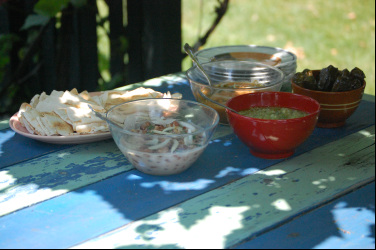 The vegetarian diet is one of the most common diets among yogis. This tendency is partially derived from the concept of Satvic foods which consists of fresh fruits, vegetables, seeds, nuts, tofu, beans, dairy products, and honey, as well as fruit or vegetables juices. However, there are many other reasons for choosing a vegetarian diet; for example, health considerations, environmental and economic factors. Some people may have concerns about animal welfare, while others reflect on world hunger and religious beliefs. Whatever the reason, 7.3 million adults in the U.S. now consider themselves vegetarians. A classic definition of a vegetarian is someone who does not eat meat (including fowl) or seafood, or products containing these foods, but is this really that simple? There are a wide variety of vegetarian and semi-vegetarian diets including those who consume dairy products and eggs (lacto-ovo) along with the standard base of grains, vegetables, fruits, legumes, seeds, and nuts. The lacto-vegetarians exclude eggs, and vegans are sometimes called ‘total vegetarians’ excluding from their diet fish, meat, poultry, dairy, egg, as well as any other animal products. What about those who only eat fish (pesceterians), or those who only eat vegetables, grains and legumes (macrobiotic diet)? According to the Academy of Nutrition and Dietetics (formerly known as the American Dietetic Association), these types of diets are classified as ‘near-vegetarian’ diets. As my husband commented wisely: “Those are the folks who eat hamburger near an Indian restaurant”. Seriously, a raw food diet can be vegetarian, consisting of mainly uncooked and unprocessed foods, but it can also include unpasteurized dairy products, raw meat and raw fish. (I will comment on the dangers of such eating patterns in my future blogs). Fruitarian diets are considered vegan and based primarily on fruits, nuts and seeds. They can also include vegetables classified botanically as fruit, such as tomatoes and avocadoes. Of course, there are always folks who will eat meat and fish occasionally, but describe themselves as vegetarians. This particular case will fit under category of semi-vegetarians. Although not a vegetarian myself, I love making vegetarian dishes. They are always fresh, and often include many ingredients and spices. The good news is that the Academy of Nutrition and Dietetics recognizes those diets as healthy, and when well-planned (nutrient-wise), they may have a number of health advantages. For example, vegetarian diets were associated with lower cholesterol, lower risk of heart disease, lower blood pressure and hypertension, as well as lower body mass index (BMI) and lower risk of type 2 diabetes. So, keep munching and stay tuned! The next blog will be dedicated to macro- and micro-nutrients in vegetarian diets. 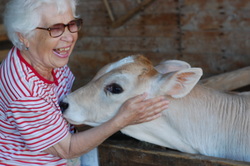 Did you know that Yoga was not always taught to women? In male dominated India women faced many rules and restrictions related to their menstrual cycle - in some cases they were declared ‘untouchable’ for the duration of this period. Fortunately, modern knowledge has changed this situation, and now more women-practitioners (termed ‘yogini’) are entering the spiritual and physical world of Yoga. According to Chandra Cuffaro, a yoga teacher from the Krigshnamacharya Health and Yoga Foundation in Rome as well as a long-time practitioner, women go through seven parinamas (transformations) throughout their lives. Yoga helps to cope with these transformations, and offers much needed support during these times. The first parinama occurs during puberty when a girl’s body changes and takes on a more rounded shape. Often, especially in modern times, these changes can be regarded as negative and undesirable. Yoga helps young girls understand their bodies and the changes that come with physical maturation; they learn to appreciate their new form and properly maintain it through exercise and a balanced diet (not starvation). The second parinama happens when the young woman marries and has to adjust to a new life with another person. Marriage means ‘sharing’ and sharing means adjusting. Everything in her life is going to be different now, and Yoga, especially the spiritual, meditative part will offer a great deal of mental help. The third parinama is pregnancy. A woman’s physiological and emotional levels are suddenly and simultaneously exploding; she has no idea how to handle this situation. Yoga provides a phenomenal balancing power that gives stability and calm, and allows the woman to enjoy this precious moment of binding with another being. The fourth parinama extends throughout the entire period of pregnancy – it encompasses a major transformational period which alters the woman biologically and mentally. Again, through regular practice Yoga helps build the most wonderful relationship between the mother and baby. We now arrive at the time of delivery – the fifth parinama. Along with joy there is always fear of pain, problems with delivery, concerns for the child’s health, and much more. These worries could be overwhelming for a woman, and may intensify any upcoming issues if she is not adequately prepared. Regular Yoga practice during pregnancy can increase focus and build proper breathing techniques thereby attenuating any possible negative outcomes. At this point you can probably guess that the sixth parinama is the post-partum time when a woman is adjusting to less sleep, less time for herself, and establishing an amazing connection with the newborn. In many cases a woman must show her husband that his role as a father is very important, that she needs his help. The Yoga practice could be of utmost importance, and gives direction on how to manage this change. A long time will pass between the sixth and the seventh and last parinama. The woman will face many adjustments, but she will be ready through her continuous Yoga practice. Menopause will constitute the last stage in a woman’s transformation cycle. Chandra Cuffaro calls it ‘the phase of serenity’ when results are not as important as the quality of doing; it is the time of peace and wisdom. |
AUTHOR
Mariya Power has a Master's Degree in Nutrition and Food Science from the University of Vermont; has conducted research on effects of cinnamon extract in type II diabetes, and is a passionate yoga enthusiast. Archives
March 2015
Categories
All
|
Web Hosting by IPOWER
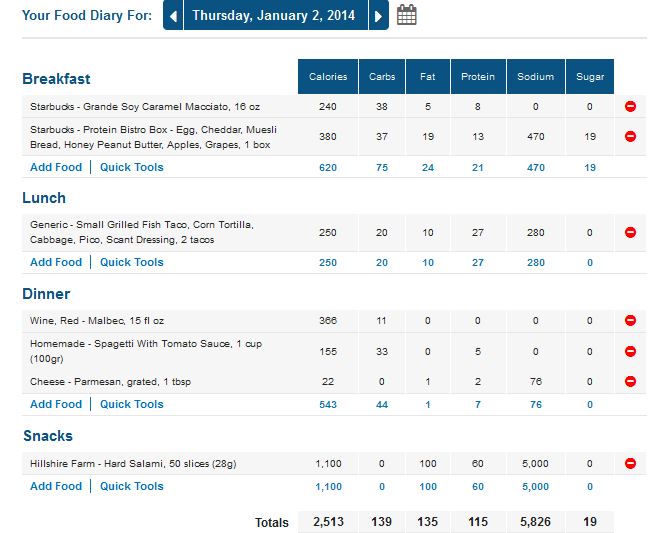

 RSS Feed
RSS Feed